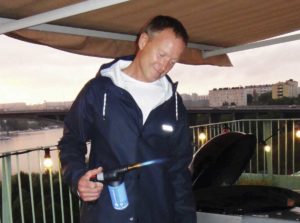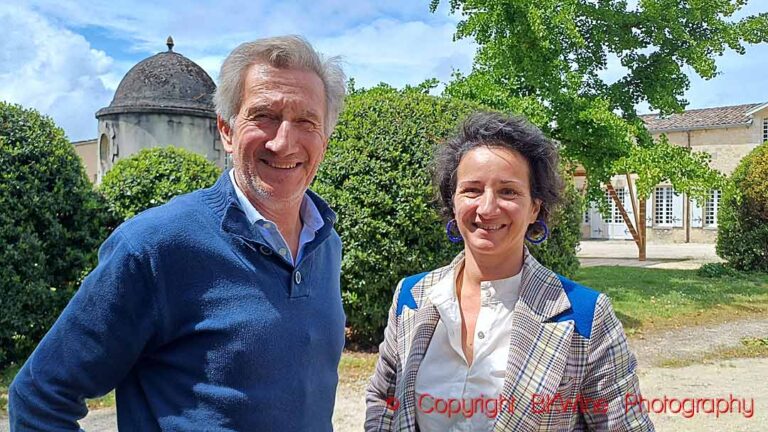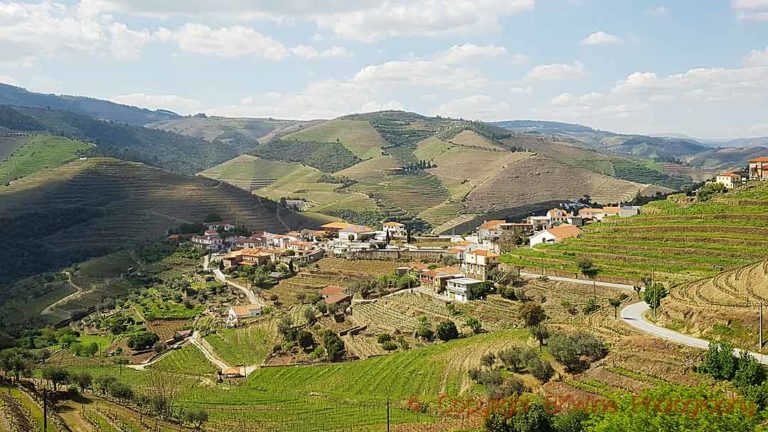Hällåkra Vingård breaks new ground for Swedish wines. Delicious lunch tasting in Skåne.
“Ambitious” is the short summary of the visit to Hällåkra winery (Hällåkra Vingård) in Skåne (Scanie). Framed with wheat fields, oilseed rape and sugar beet in Sweden’s granary, neat rows of vines grow. Both the farmers in the area and Sweden’s wine elite shook their heads when Håkan Hansson planted the first vine in 2003. Today we can state that it is excellent to make wine in Sweden.
On the other hand, connecting the aroma and taste experience to the old world’s often well-known points of reference is not a good idea. It’s well done, it’s challenging and it’s rich in new impressions. The winemaker has succeeded but it is with a completely new palette of stunning aromas and flavours.
Arriving first on site at ten past eleven. The rainshowers have passed and Michael and Joanna Daly are setting the table for visitors to the vineyard’s restaurant. Joanna makes a stop in the garden and fills the basket with herbs, lettuce and vegetables. Anyone who advocates local production has come to the right place. Winemaker Håkan Hansson shows up in work clothes and with secateurs in his hand. What else? Håkan starts by saying that he has a lot to do, but once the conversation has started, he settles down and takes time to chat. If you are interested in wine, you will feel welcome at Hällåkra.
“We grow vines on 6.5 hectares,” says Håkan, “but we can grow to three times that area on our own land. Perhaps most exciting is the work with pinot noir, where we will soon start commercial production. Speaking of pinot, we harvested once in November. Then, even the leaves had begun to fall, even though the fruit was intact.”
Solaris is the green white that dominates today, and rondo for red wines. They do already use pinot noir, but only as a small portion in their white wine.
The tasting was a challenge in finding words and connections to the flavours that blossomed. Fortunately, I was given place to sit alone in a conference room sheltered from the wind in the garden where most things were served. Out there, I would have missed the absolute best of the show, the aromas on the nose. All wines offered rich, colourful personas, completely in a style of their own.
Farmarvin 2013, Hällåkra Vingård
The name means ”Framer Wine”. Rondo 90%, regent 5% and leon millont 5%. SEK 177 in the on-order range at Systembolaget. Aged for seven months in new French and Swedish oak, no filtration, no clarification. Alcohol content 10.2%.
Balanced nuances, fresh dark fruit, blueberries. Can’t really find the oak, or if so, softly integrated, more cedar-wood in that case, and a hint of teak oil. Overall, a pleasant journey of discovery among distinct aromas. The taste brutally breaks with the lovely aroma. Demanding and with insanely high acidity. Fresh fruit and a light viscosity do not quite reach the strong tannins and the intensity of the acidity. Food feels like a reasonable requirement for the wine.
Farmarvin 2016, Hällåkra Vingård
Same as above with the exception of the vintage and ageing only in French barrels.
More restrained in the nuances. Delicious chemical undertones. Compared to 2013, it feels like the wine is restraining all the details. However, the taste is much more harmonious than in the 2013. Undoubtedly an exciting wine, but drinking it now is something of an infanticide. I take the liberty of saying that the wine must be aged in order to be experienced in a good way.
Solaris M 2018, Hällåkra Winery
Solaris 100%, skin contact for four days, no filtration, no clarification. 13% alcohol, residual sugar not stated. SEK 243 in the on-order range at Systembolaget.
Soft, delicious, dry toffee and home-cooked caramel. Difficult to place, nice and clean tones. Refreshing, fat, massive and stylish. Lovely body, budding acidity and a certain skin-astringency or possibly bitterness. I feel a bit lost in finding descriptions. A demanding wine, insanely delicious and at the same time challenging. Long and lovely aftertaste. Bone dry and with a delicious saltiness that stays on the lips, much like after a dry fino. For those of you who appreciate balanced, acidity-driven wines, this is an interesting acquaintance.
Jöns 2019, Hällåkra Winery
Solaris 100%. Indigenous yeast fermentation without additives on steel tank. Skin-maceration three days. No sulphite additives. “An analysis revealed that we are 3 mg above the limit value and were forced to add a warning text that the wine contains sulphites”, growls Håkan Hansson, and adds that any plonk in bag-in-box is at a tenfold level. 11.5% alcohol. SEK 243 in the on order range at Systembolaget.
Powerful nose. Clean, solid and dry, distinct resin character and balsa wood. Hints of sweetness and flowers. Really delicious in its peculiar style. Nice viscosity, faint shades of “natural wine”, clear acidity but not mean. Long and pleasant aftertaste. A well-balanced, rich and playful wine.
Margareta 2019, Hällåkra Winery
Same as for Jöns but with two days of skin contact instead of three.
A fresher, lighter tone with a budding energy that was not found in Jöns. The wine was slightly bubbly, which may well have been a bottle variation. Unfortunately, I could not double check with the winemaker who had left the farm and gone out into the field. Slightly more pointed acidity than Jöns.
“We aim for biodynamic cultivation,” says Håkan, “with the goal of certifying ourselves as the first Swedish vineyard at Demeter. French restaurants have started to ask for our wines, but guaranteeing the delivery volumes is something we must solve.”
What about the food then?
The menu was from locally produced ingredients solidly rooted in Scanian soil. It is definitely worth a trip in itself. Very well-prepared, well-composed and with a nice balance. The wines are already available at Noma in Copenhagen and Bhoga in Gothenburg. But I wonder if it is not here at Hällåkra that they are experienced in the very best way.















